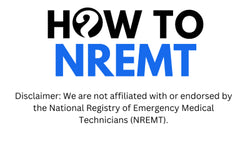When you sit down for the NREMT exam, it’s not just your memory that’s being tested; it’s your ability to make decisions like a provider in the field. Many EMT students prepare by drilling facts, acronyms, and vital sign ranges. While that knowledge is essential, the real exam challenge is applying it under pressure, just as you’ll have to do on real calls.
This is where mental modeling comes in. By learning to think like a paramedic before you take your EMT exam, you can improve both your test performance and your clinical reasoning. Mental modeling builds frameworks in your mind that help you connect symptoms, prioritize interventions, and choose the best path forward in complex situations. It’s less about memorizing isolated facts and more about building a structured way of thinking.
In this blog, we’ll break down what mental modeling means, how EMTs can adopt paramedic-level decision-making strategies, and how these skills directly prepare you for the adaptive structure of the NREMT exam.
What Is Mental Modeling and Why Does It Matter?
A mental model is a structured representation in your brain of how something works. In EMS, it means having a mental playbook for approaching patient care systematically. For example, instead of just remembering “low oxygen = give oxygen,” you have a framework that considers:
·What’s the patient’s primary complaint?
·What immediate threats do I need to rule out?
·What’s the quickest way to stabilize them while continuing assessment?
This kind of thinking mirrors how experienced paramedics operate. They don’t just recall treatment steps; they constantly weigh risks, priorities, and resources.
For EMT students, adopting these models early has two benefits:
1. Better Exam Performance: The NREMT exam doesn’t just test recall; it tests whether you can apply information in context. Mental models guide your thought process, so you’re less likely to get lost in the question’s details.
2. Clinical Readiness: Beyond the exam, mental models train you to think like a provider in the field, preparing you for unpredictable calls where seconds matter.
Building a Systematic Approach
Thinking like a paramedic starts with building a systematic approach to patient care. This prevents tunnel vision and ensures you don’t miss critical steps.
1. Use Algorithms and Checklists
Protocols, flowcharts, and checklists aren’t just paperwork; they’re memory aids designed to keep your care comprehensive. For example, the systematic approach to chest pain isn’t just “give aspirin.”
A paramedic thinks:
·Rule out immediate life threats (is the patient unstable?).
·Support airway, breathing, circulation.
·Gather a focused history and risk factors.
·Determine transport priority.
By practicing with these structured guides, you can train your brain to approach NREMT questions with the same clarity.
2. Develop Metacognition
Metacognition means “thinking about your thinking.” It’s the ability to step back and ask: Am I being systematic? Did I miss a step? What’s the most urgent need here?
On exam day, this is the difference between rushing to the first “right-looking” answer and calmly evaluating all options through a structured lens.
3. Set Patient-Centered Goals
Instead of memorizing treatments in isolation, focus on patient-centered outcomes.
For example:
·Goal: Improve oxygenation.
·Path: Administer oxygen, monitor SpO2, prepare for ventilation if necessary.
This mindset keeps you aligned with the patient’s needs, not just test answers.
Practicing Patient Assessment With Mental Models

Patient assessment is where mental modeling shines. The more systematic your approach, the better your performance on both exams and calls.
1. Hands-On Practice
While the NREMT exam no longer tests psychomotor skills nationally, practicing physical assessments still builds the habits you’ll need in real scenarios. Running through mock assessments with classmates or manikins helps cement a mental flowchart of what to check and when.
2. Simulation and Scenarios
Simulation training, even at the classroom level, lets you apply your models under time pressure. For example, in a simulated shortness-of-breath call, you may need to decide whether to prioritize oxygen administration, suctioning, or transport. These scenarios train your ability to sequence interventions correctly, which is exactly what the NREMT cognitive exam is designed to measure.
Cultivating the Paramedic Mindset
Technical knowledge is only half the battle. To truly think like a paramedic, you need to adopt the mindset that allows for clear, patient-centered decisions under stress.
1. Stay Calm and Positive
High-pressure environments trigger anxiety, which clouds decision-making. Practicing stress management (through deep breathing, visualization, or brief mindfulness exercises) prepares you to focus even when the exam clock is ticking.
2. Develop Intuition Through Practice
While systematic approaches are essential, intuition also plays a role. Experienced providers often describe a “gut feeling” that something is wrong. That intuition is actually rapid pattern recognition built through repeated exposure. As a student, you can begin to develop this by reviewing case studies, running scenarios, and reflecting on what signs pointed to the diagnosis.
3. Seek Mentorship
One of the fastest ways to build mental models is to learn directly from experienced paramedics. Ask them not just what they did, but why. Their explanations often reveal decision frameworks you can adopt.
How Mental Modeling Prepares You for the NREMT Exam
The NREMT’s Computer Adaptive Testing (CAT) algorithm doesn’t ask random questions; it adapts to how you think through problems. That’s why mental modeling is such a powerful prep tool.
1. One Question at a Time
The NREMT exam requires you to approach each question as if it’s a new patient. Mental models give you a ready-made framework to apply every time, instead of panicking or guessing.
2. Application Over Memorization
Questions are scenario-driven, not recall-driven. For example, instead of asking you to list symptoms of shock, the exam may describe a patient with low blood pressure, rapid pulse, and altered mental status. Without a mental model of shock recognition and management, you risk missing the point.
3. Efficiency Under Pressure
By rehearsing systematic thought processes in micro-scenarios, you reduce hesitation. The exam has time limits, and clear frameworks help you move efficiently from question to question.
Practical Strategies to Train Your Mental Models
Here are some actionable ways to train yourself to think like a paramedic before your exam:
1. Case Studies: Read short EMS case studies and outline your thought process. What was the priority problem? What interventions came first?
2. “If-Then” Scenarios: Build simple rules in your head. Example: If chest pain + hypotension = suspect cardiogenic shock.
3. Flowchart Drills: Sketch decision trees for conditions like stroke or respiratory distress, then practice applying them to sample questions.
4. Verbal Walkthroughs: Talk through your patient assessment steps out loud. This not only reinforces memory but helps you notice gaps in your process.
5. Peer Practice: Work with classmates to quiz each other on scenario-based problems, focusing on reasoning, not just answers.
Building Paramedic Thinking Into EMT Prep

Mental modeling bridges the gap between memorizing facts and thinking like a provider. By practicing systematic approaches, developing metacognition, and simulating real scenarios, NREMT students can sharpen the exact skills the exam is designed to test.
At How To NREMT, we believe the best NREMT test preparation goes beyond flashcards; it builds decision-makers. That’s why we train our students to build and practice these mental models every day, so when they sit down for the exam, they already think like providers. If you’re ready to strengthen your reasoning, improve your test performance, and step confidently into the EMS role, we’re here to help.
Start building the mental models you need with our Full Access Membership or take it further with Private Coaching and Tutoring. Together, we’ll help you think like a paramedic and pass your NREMT exam on the first attempt.

